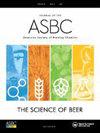应用Plasckett-Burman实验设计研究八种植物激素对麦芽品质参数的影响
IF 1.8
4区 农林科学
Q4 BIOTECHNOLOGY & APPLIED MICROBIOLOGY
Journal of the American Society of Brewing Chemists
Pub Date : 2023-07-03
DOI:10.1080/03610470.2022.2084673
引用次数: 0
摘要
摘要大麦是啤酒酿造工业的主要原料。种子发芽是制麦芽的一个基本过程,受到物理和化学因素的影响,尤其是植物激素的影响。众所周知,植物激素赤霉素(GA)和脱落酸(ABA)是拮抗调节大麦发芽的主要激素。其他植物激素,包括生长素(IAA)、乙烯(ET)、油菜素甾体(BR)、茉莉酸(JA)、水杨酸(SA)、细胞分裂素(CTKs)和己果内酯(SL),也通过介导ABA/GA平衡来调节种子发芽。本研究对大麦发芽过程中添加的8种激素的影响进行了研究。采用有效的实验方法设计来评估八个因素(α-淀粉酶、β-淀粉酶、极限糊精酶、β-葡聚糖酶、麦芽汁糖度、FAN和β-葡聚糖含量)对上胚轴和根伸长的影响。几乎所有研究的植物激素都对大麦上胚轴的伸长起着重要作用。GA、ET、BA(苄氨基嘌呤)和玉米素(ZEA)的作用增强,而ABA、SA和BR对α-淀粉酶、β-淀粉酶、极限糊精酶和β-葡聚糖酶活性的作用降低。结果表明,除GA和ABA外,SA、ET、BR、BA、ZEA和JA对麦芽品质也有显著影响。这些植物激素之间的平衡对大麦的麦芽品质至关重要。这些结果的未来应用可以提高人们对植物激素对麦芽品质影响的认识,并为提高麦芽品质提供具体的思路。本文章由计算机程序翻译,如有差异,请以英文原文为准。
Application of Plackett-Burman Experimental Design for Investigating the Effect of Eight Phytohormones on Malt Quality Parameters
Abstract Barley is the major raw material for the malting and brewing industries. Seed germination is a fundamental process for malting and is affected by physical and chemical factors, especially plant hormones. It is well recognized that the phytohormones gibberellic acid (GA) and abscisic acid (ABA) are the primary hormones that antagonistically regulate barley germination. Other plant hormones, including auxin (IAA), ethylene (ET), brassinosteroid (BR), jasmonic acid (JA), salicylic acid (SA), cytokinins (CTKs), and strigolactone (SLs) also regulate seed germination by mediating the ABA/GA balance. In this study, the effects of eight hormones added during barley germination were investigated. An efficient design of the experimental method was employed to assess the effect of eight factors (α-amylase, β-amylase, limit dextrinase, β-glucanase, wort sugar profile, FAN, and β-glucan content) on epicotyl and root elongation. Almost all studied phytohormones played a significant role on barley epicotyl elongation. GA, ET, BA (benzylaminopurine), and zeatin (ZEA) exerted an increased effect, while ABA, SA, and BR showed a decreased effect for α-amylase, β-amylase, limit dextrinase, and β-glucanase activity. Results showed that in addition to GA and ABA, that SA, ET, BR, BA, ZEA, and JA also had significant effects on malt quality. The balance between these phytohormones is vital to the malting quality of barley. Future applications of these results could improve current recognition about the effects of phytohormones on malting and provide concrete ideas for enhancing malt quality.
求助全文
通过发布文献求助,成功后即可免费获取论文全文。
去求助
来源期刊

Journal of the American Society of Brewing Chemists
工程技术-生物工程与应用微生物
CiteScore
4.00
自引率
20.00%
发文量
41
审稿时长
3 months
期刊介绍:
The Journal of the American Society of Brewing Chemists publishes scientific papers, review articles, and technical reports pertaining to the chemistry, microbiology, and technology of brewing and distilling, as well as the analytical techniques used in the malting, brewing, and distilling industries.
 求助内容:
求助内容: 应助结果提醒方式:
应助结果提醒方式:


